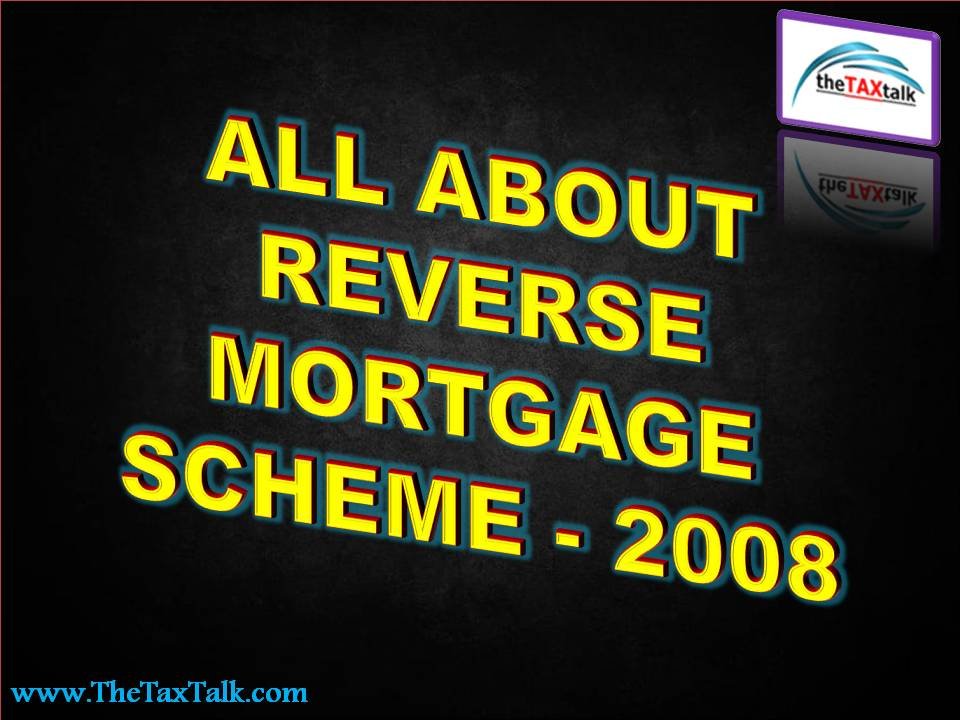![]()
ALL ABOUT REVERSE MORTGAGE SCHEME – 2008
There is no social security mechanism which is prevalent in India. One of the major concerns of post-retirement life is the lack of regular income. Having a steady flow of income is the need of the hour for senior citizens. With the help of a reverse mortgage, senior citizens across the country can take care of their day-to-day expenses and live a financially independent life by mortgaging their property. Let us have a look at the complete Reverse Mortgage Scheme -2008 with amendment till date:
Reverse Mortgage Scheme, 2008
In exercise of the powers conferred by clause (xvi) of section 47 of the Income-tax Act, 1961 (43 of 1961), the Central Government hereby makes the following scheme, namely:—
1. Short title, commencement and application
(1) This scheme may be called the Reverse Mortgage Scheme, 2008.
(2) It shall be deemed to have come into force from the 1st day of April, 2008.
(3) Save as otherwise provided in the Scheme, it shall be applicable to all eligible persons.
2. Definitions
In this Scheme, unless the context otherwise requires,—
(a)”Act” means the Income-tax Act, 1961 (43 of 1961);
(ab) “annuity sourcing institution” means Life Insurance Corporation of India or any other insurer registered with the Insurance Regulatory and Development Authority established under sub-section (1) of section 3 of the Insurance Regulatory and Development Authority Act, 1999 (41 of 1999)]
(b) “approved lending institution” means—
(i) National Housing Bank established under section 3 of the National Housing Bank Act, 1987 (53 of 1987);
(ii) a scheduled bank included in the Second Schedule to the Reserve Bank of India Act, 1934; or
(iii) a housing finance company registered with the National Housing Bank;
(c) “Board” means the Central Board of Direct Taxes constituted under the Central Boards of Revenue Act, 1963 (54 of 1963);
(d) Capital asset” means a residential house property which is located in India;
(e) eligible person” means—
(i) any person, being an individual, who is of, or above, the age of sixty years; or
(ii) any married couple, if either of the husband or wife is of, or above, the age of sixty years;
(f) “Reverse Mortgage” means mortgage of a capital asset by an eligible person against a loan obtained by him from an approved lending institution;
(g) “reverse mortgagor” means the eligible person who has mortgaged the capital asset for the purpose of obtaining loan;
(h) “reverse mortgage transaction” means a transaction in which the loan may be disbursed to the reverse mortgagor but does not include transaction of sale, or disposal, of the property for settlement of the loan;
(i) all other words and expressions used herein, but not defined and defined in the Act, shall have the meanings respectively assigned to them in the Act.
3. Application and processing for reverse mortgage transaction
(1) Any eligible person may enter into a reverse mortgage transaction by applying in writing to the approved lending institution, if the capital asset, being mortgaged, is—
(i) owned by him; and
(ii) free from any encumbrances.
(2) The application under [2][sub-paragraph (1)]shall be processed by the approved lending institution and for this purpose the institution may charge nominal amount as processing fees.
4. Sanction of reverse mortgage loan
(1) The approved lending institution, before taking mortgage of capital asset and before disbursing any loan under reverse mortgage, shall—
(a) enter into a loan agreement in writing with the reverse mortgagor; and
(b) obtain and maintain the following particulars from the reverse mortgagor, namely:—
(i) Name and address of the owner of the capital asset;
(ii) Permanent Account Number of the owner of the capital asset;
(iii) Total area, including built up or covered area, of the capital asset;
(iv) Cost of acquisition and the year of acquisition of the capital asset;
(v) Cost of improvement and the year of improvement of the capital asset;
(vi) Name, address and Permanent Account Number of all the legal heirs and estate of the owner of the capital asset;
(vii) A copy of the registered will of the owner of the capital asset including any changes made therein during the currency of the term of the loan.
5. Disbursement of loan. –
The approved lending institution may disburse the loan, –
(a) to the reverse mortgagor by any one or more of the following modes, namely:-
(i) periodic payments to be decided mutually between the approved lending institution and the reverse mortgagor;
(ii) lump-sum payment in one or more tranches, to the extent that the aggregate of the amount disbursed as lump sum payments does not exceed fifty per cent of the total loan amount sanctioned; or
(b) in part or in full, to the annuity sourcing institution for the purposes of periodic payments by way of annuity to the reverse mortgagor.]
6. Period of reverse mortgage loan.-
The loan under reverse mortgage shall not be granted for a period exceeding,-
(i) twenty years from the date of signing the agreement by the reverse mortgagor and the approved lending institution, where the loan is disbursed in accordance with clause (a) of Paragraph 5;
(ii) the residual life time of the borrower, where the loan is disbursed in accordance with clause (b) of Paragraph 5]
7. Repayment of loan
The reverse mortgagor, or his legal heirs or estate, shall be liable for repayment of the principal amount of loan along with the interest to the approved lending institution at the time of foreclosure of the loan agreement.




